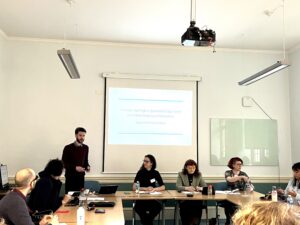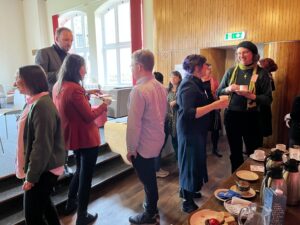by Antonia Anstatt (Merton, University of Oxford) and Ed van der Molen (University of Nottingham)
The ‘Gender and Sainthood, 1100-1500’ Conference was held at the History Faculty of the University of Oxford on the 5th and 6th of April 2024, and was organised by Antonia Anstatt (University of Oxford) and Ed van der Molen (University of Nottingham). Bringing together scholars from the UK, Germany, Italy, Spain, Canada, and the US, the conference aimed to place the complex cultural categories of sanctity and gender into conversation with each other via the methodological lens of queer theory and trans studies. While the relationship between sainthood and gender has been well-trodden ground in the field for some time thanks to the work of scholars such as Caroline Walker Bynum, Barbara Newman, and John Coakley, and the increasing awareness of medievalists of the possibilities that trans and queer theories offer to a wide range of areas of research made now an opportune time to revisit this familiar convergence of categories from a new and exciting angle.
The conference took as its starting point the 2021 publication of Trans and Genderqueer Subjects in Medieval Hagiography, edited by Alicia Spencer-Hall and Blake Gutt. This volume starts from the premise that ‘the co-incidence of medieval representations of non-normative gender with representations of holiness is no coincidence. There is a deep structural connection between these categories of exceptional life’ (p.13), and thus sets out to untangle and illuminate this connection. We felt that building on the excellent work of the contributors to this volume offered the possibility of continuing the momentum of this new approach to the study of sainthood, and also spoke to the contemporary political needs of the moment, in which the medieval past is increasingly weaponised by the Western political right as a period where categories of gender, sexuality and race were fixed and homogenous. Scholarly attention to the complexity and fluidity of these identities over the course of the Middle Ages offers a counter-narrative, and enables us to perceive the richness and diversity, both familiar and removed, of medieval lived experience. The insights offered by a more fluid and flexible understanding of medieval gender are by no means confined to those who explicitly cross or queer gender boundaries. We cannot understand the transcendence of gender if we don’t understand underlying expectations of gender, both masculinity and femininity. Queer and trans theories therefore have much to offer in terms of perceiving the constructions of masculinity and femininity that formed normative gender patterns in the Middle Ages, and how saints could explore the boundaries of these categories both for themselves and their worshippers. Hagiography and saintly iconographies can reveal much about how, in the imagination of their devotees and hagiographers, saints could explore, challenge, or confront medieval expectations of femininity and masculinity, by disrupting, disquieting, or altogether transcending them. The questions that all these approaches show, are of course: to what extent are the saints really challenging medieval expectations, and to what extent do they disrupt our own ideas of what the past ‘looked like’?

Photograph of attendees in a seminar room at the Gender and Sainthood 1100-1500 conference, Oxford 5-6 April 2024. Photograph by Antonia Anstatt, all rights reserved (2024)
The conference consisted of seven panels with three papers each, spread out over the two days. Some of the papers conducted broader methodological approaches, others used a specific corpus or focused on one or two case studies. Their approaches to the question of gender and sainthood were rich and varied: some analysed the non-binarity or queerness of their case studies (panels ‘(Trans)cending Gender’ and ‘Queering Sainthood’), others studied how saints could contradict expectations of gender (panel ‘Transgressing Gender’) or talked about the variety and wealth of medieval expressions of gender and the construction of femininity or masculinity in different contexts (panels ‘Writing Gender’ and ‘Visualising Gender’). Some focused on the construction of specific roles within gender-based relationships (panel ‘Familial and Spiritual Relationships’). The case studies discussed ranged from late antique and early medieval martyrs and their later medieval reception to late medieval married and mystic saints, and to 20th-century approaches to gender and sainthood (panel ‘Modern Perspectives’). These seven panels were complemented by a keynote lecture by Alicia Spencer-Hall, ‘Who’s Afraid of Trans and Genderqueer Saints?’, in which she traced the initial responses to Trans and Genderqueer Subjects in Medieval Hagiography, both positive and negative, and demonstrated different methodologies of studying queerness in medieval hagiographies as well as the urgent need for a broader understanding of such approaches.
The ultimate result of the conference was an increased awareness amongst all the participants of how studying the intersection of gender and sainthood through the lens of queer and trans studies can enrich our understandings of our subjects and sources, as well as point to their increasing relevance to the modern world. In our closing remarks, we pointed to three central themes that had come up repeatedly over the course of the conference, both in the papers themselves and the subsequent discussions. The first was the importance of undertaking this work now. As mentioned, the medieval past is increasingly abused as a source of right-wing cultural narratives (see for instance Albin et al. (eds.), Whose Middle Ages: Teachable Moments for an Ill-Used Past), and so doing the work to push against these narratives is important, not just from the perspective of scholarly fidelity, but also because the politics in which the medieval is deployed affects real lives, and real people. This is not simply an academic exercise, but we must consider the cultural and political work that our scholarship, as much as our sources, undertakes. In the midst of a culture-war-fuelled debate over the ‘legitimacy’ of trans experience, it is incumbent upon us as historians to illuminate the vibrancy, complexity, and instability of medieval categories of gender, and remove the medieval past as a normative weapon from the arsenal of the right.
The second theme that emerged from the conference was the nature of sainthood as a category. In her keynote, Alicia Spencer-Hall evoked the idea of gender as a mobius strip, around which one could be continually travelling, or settled at a specific point, or moving between different points. From the approaches taken by the papers, it became apparent that sanctity could be usefully thought of in a similar way. Rather than being a settled and coherent category, it can be better conceptualised as a constant process of transition, of movement, of endless becoming and unbecoming. The saint is always constructed, as Pierre Delooz argued in 1969, but they are also perpetually deconstructed, transitioning between versions and ideals. Taking this perspective, it then becomes useful to imagine gender and sanctity as two overlapping mobius strips, where different configurations and conjunctions can move a given figure to endless differing conceptualisations of gender, sanctity, or both, or even move them off one or both strips entirely. In connection with this, we can thus approach hagiography (and other literature of sainthood) as texts which unavoidably ‘trans’ their subjects. They necessarily depict processes of transition and movement along a spectrum between and against polarities, not just in terms of gender, but in terms of social status, the relationship between the human and the divine, the relationship of the saint to their cultural context, and many other aspects. Viewing the construction and deconstruction of saints through the perspective of trans studies is incredibly productive.

Photograph of attendees during a break at the Gender and Sainthood 1100-1500 conference, Oxford 5-6 April 2024. Photograph by Antonia Anstatt, all rights reserved (2024)
A further theme was the consistent emphasis on the non-binary nature of medieval gender, and its prevalence in all spheres of medieval life. Saints offer a clear case study of how gender in the medieval period could be transgressed, transcended, or performed. The medieval reader of hagiography, or audience for a sermon, would have had the instability of gender laid plainly before them, and in many cases, used as the foundation for claims of sanctity. This in turn prompts us to question the status of saints as exemplars, and how this relates to wider medieval gender practices. We know that in many cases, the devotions of the saints (asceticism, Christological piety, etc) mirrored and intensified those of the wider culture – the same is likely true of gender. We can think about the way in which saints and hagiographers used gender as a means of considering how gender might have been practiced, challenged, and used in a wider medieval context. In this way, we progress beyond simplistic binaries, and open the door to a richer and infinitely more complex tapestry of medieval cultural practice.
Overall, the conference was a resounding success. Each paper was in dialogue with many others, and the overall picture that emerged vindicated both the timing and topic of the conference. Thanks to the generosity of Past and Present, we were also able to provide lunch and (ample) coffee breaks for attendees on both days of the conference, meaning that there were great opportunities for networking and developing future collaborations between scholars working on different geographic and chronological contexts, but whose work deals with many of the same themes. We hope to see the fruits of these collaborations over the next few years, and are immensely grateful to all our panellists, our keynote speaker, and our funders, for a hugely productive and supportive event. We close with a note from our keynote speaker, posted on Bluesky on the second day of the conference: ‘The problem of attending a really great conference which makes you feel seen and understood as a scholar and a person is that they end’.
Past & Present was pleased to support this event and supports other events like it. Applications for event funding are welcomed from scholars working in the field of historical studies at all stages in their careers.
